The thoracic spine consists of 12 vertebrate located between the seven cervical and five lumbar vertebrate. This region of the spine consists of a posterior curve in the spine and requires mobility for flexion, extension, lateral flexion and rotational movements of the torso. Therefore, the thoracic spine is meant to be mobile, while the lumbar spine is meant for stability.
Both active and sedentary lifestyles affect thoracic mobility, or lack thereof. When poor posture exists, kyphosis, which is an increased posterior thoracic curve, results in rounded shoulders, forward-head tilt and anterior tilt of the pelvis. Lack of mobility may result in pain, discomfort and compensation in the areas above or below the thoracic region.
It is common for people who are sedentary to use their lumbar spine for mobility, which may result in lower-back pain. In addition, shoulder and neck discomfort may occur from immobile thoracic spines, as the scapula may not glide properly and the rounded shoulders decrease the sub-acromial space, the place where impingement may occur. Thus, faulty movement patterns must be retrained so the spine and kinetic chain function properly.
Increased and properly functioning thoracic mobility results in better movement, during both activities of daily living and during athletic pursuits. This results in efficient movement, better motor control and less energy expenditure.
The following mobility exercises can be used in personal-training sessions or as part of a group exercise warm-up. The goal is open the interconnected musculature between the “hips and the pits,” with emphasis on thoracic movements. The arms and thoracic spine move in all three planes of motion, integrating coordination and movement patterns as well as promoting mobility of the thoracic spine and hips.
This series can be completed for a certain number of repetitions (10 to 12 on each side, for example) or for a certain amount of time (20 to 30 seconds on each side). You may also choose to complete this routine either by focusing on the right side of the body first and then switching to the left, or by alternating right and left.
Standing Reach and Pulls
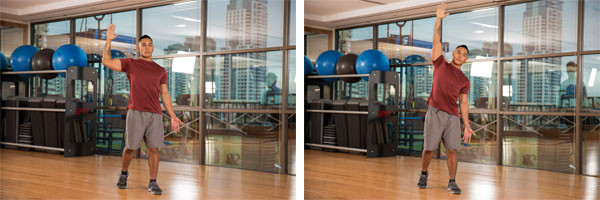
Purpose: Lateral flexion
How to Perform: Step the right foot behind (about one stride length) and remain on the ball of the right foot (heel off the ground). Bend the right elbow to 90-degrees and keep the left arm straight, fingers pointing to the floor. Reach the right arm overhead while laterally flexing the spine (toward the left) to feel the length through the right side body. Continue this motion before switching to the left side.
Standing Rotation (Basic)
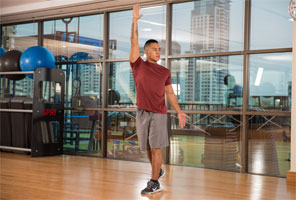
Purpose: Rotation with slight extension
How to Perform: Step the right foot behind (about one stride length) and remain on the ball of the right foot (heel off the ground). Reach the right arm upward (keeping a soft bend at the elbow) and lengthen the left arm down so the fingers point toward the floor. Rotate toward the left inner thigh and reach the arms long—imagine the fingertips trying to reach higher and lower with each movement. As the right arm reaches, slight extension may occur in the spine. Return to center. The length should be felt through the right oblique and side body. Continue the motion before switching sides.
Standing Rotation (Advanced)
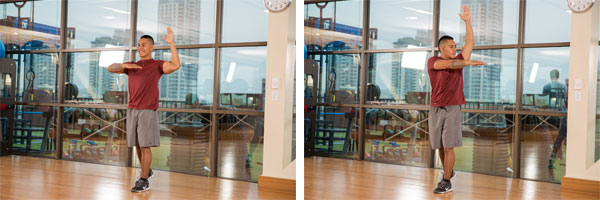
Purpose: Rotation with slight lateral flexion
How to Perform: Step the right foot behind (about one stride length) and remain on the ball of the right foot (heel off the ground). Bend the right elbow to 90-degrees with the hand in front of chest and palm facing the floor. Bend the left elbow to 90-degrees with the fingers facing upward and palm facing forward. Rotate toward the left inner thigh and simultaneously extend both arms (the right arm reaches across the body and the left arm lifts overhead). The rotation and arm movement causes slight lateral flexion toward the right. Return to center and continue this motion. Repeat on the opposite side.
Runner's Lunge With Rotation
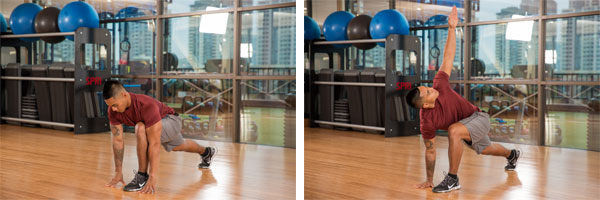
Purpose: Rotation with hip opening
How to Perform: Assume a runner’s lunge position, with the right leg behind and the left ankle under the knee. Place one hand on each side of the front foot. (To make the exercise easier, place the right knee on the ground). Reach the left arm overhead and rotate the torso toward the left inner thigh. Release to center and continue this motion. Repeat on the opposite side.
Side Lunge With Torso Rotation
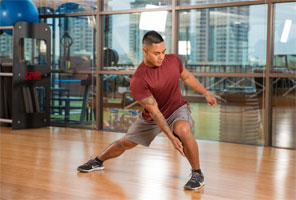
Purpose: Rotation and lengthening of the inner thigh
How to Perform: Stand tall and step the left leg into a side-lunge position. Reach the right hand toward the left calf and rotate the torso rotates slightly toward the inner thigh. Step back to the starting position. Continue this motion on the left leg and then repeat on the opposite leg.
Quadruped Rotation
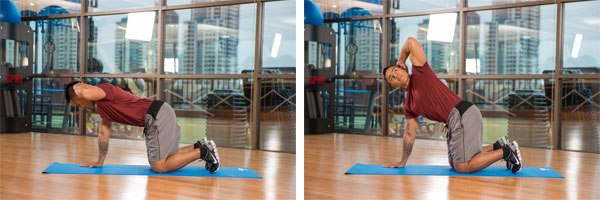
Purpose: T-spine rotation
How to Perform: Start on all fours, with knees hip-distance apart and the hands shoulder-width apart. Place the right hand on the back of the head, with the arm and torso facing the floor. Rotate away from the body as the elbow reaches upward. Return to the starting position. Continue this motion and then switch sides.
 By Elizabeth Kovar
By Elizabeth KovarElizabeth Kovar M.A, personal trainer and yoga/fitness instructor, earned Yoga Alliance 318 hours in Ashtanga yoga & Chakra Meditation from the Ayurveda & Yoga Retreat and Hospital in Coonor, India. She studied yoga in five different countries, and learned through some of the best names in the yoga industry. Her Master’s Thesis “Creating Yoga Programs for People with Movement Disabilities” was implemented on a 12 week research study for people with Stage 1-2 Parkinson’s Disease with the University of Toledo Physical Therapy and Neurology Department. She resides in Seattle, WA and is the fitness coordinator at the City of Lynnwood Recreation Center. Elizabeth is also a freelance fitness / travel writer, workshop presenter and instructs an online Yoga 1 & 2 course for Walla Walla Community College. Questions or comments can be directed to erkovar@yahoo.com
Комментариев нет:
Отправить комментарий